Text
A Year of Film Fests .... and Awards!
A year of Film Fests! Wow ... too long ... well over a year since our last blog post with word of our drive-in US premiere in Tennessee. Yes, we have been busy!
So let’s catch you up.
Numerous awards since that time, from our Jury Prize at the San Luis Obispo Int’l Film Fest, and our Best Feature Doc at Footcandle Film Festival then our Best Feature Doc prize at SCAD Savannah. And numerous "Human Spirit" accolades along the way have included the prize at Chagrin Indie in Ohio. We just had word!
[Photo] Director Paul Angell celebrating the Chagrin award with Associate Producer Alex Zdan!

Looking forward to 2022 and screenings in Appalachia. We want to help sort out the endemic USA healthcare disparity Stan set out to solve!
0 notes
Text
MedMan movie gets a drive-in World Premiere as part of 51st NashFest!
It’s official! Medicine Man: The Stan Brock Story - our movie about Tennessee-based Remote Area Medical founder Stan Brock - has been selected for Nashville Film Festival 2020!
It’s currently available to watch ANYWHERE in the USA through October 7th as part of #NashFest and you can pre-book a screening now by visiting:
https://tinyurl.com/y27kh7d6

Are you based in East or Central Tennessee? Make sure to come along for the movie's OFFICIAL LIVE PREMIERE on the evening of Tuesday, October 6th at #Maryville TN's historic Parkway Drive-in! https://www.parkwaydrivein.com. Most film festivals are staying virtual, so this will be something special. And RAM volunteers will be coming down to add huge volunteer spirit to this exclusive event!
FREE drive-in premiere tickets are available from: https://tinyurl.com/y2og26mw. And all proceeds from voluntary donations on the night will benefit #RAM. The screening will begin 40 minutes after sunset, approx 8pm. Free admission from 7pm.
Further event information from: https://www.ramusa.org/medicineman, also https://www.parkwaydrivein.com/movie-listings
This film has been a long time coming, so from the MedMan film team, just massive kudos / thanks to you all for your faith and support these many years! Thanks to everyone who's rooted for us! ❤️🙏
This film is a reminder about the unifying power of volunteerism. A bright light in darker days. Please share this link if you can: https://www.facebook.com/404055059653490/posts/3638313392894291
https://nashvillefilmfestival.org/

#nashvillefilmfestival#volunteerism#parkwaydrivein#remoteareamedical#RAM#stanbrock#premiere#maryville#blountcounty#specialscreening#nashfest#covidsafe
0 notes
Text
Adm. Brett Giroir says mask-wearing in public is 'absolutely essential.'
"Adm. Brett Giroir, a member of the White House coronavirus task force, called mask-wearing in public, which has been met with resistance in some U.S. states, 'absolutely essential.'

This comes as Florida hit a grim milestone Sunday, shattering the national record for a state’s largest single-day increase in positive cases.

RAM and Stan supporters will remember Giroir for his visit to RAM's 2018 Durant, Oklahoma clinic at Southeastern Oklahoma State University, with Rear Admiral Joan Hunter and Surgeon General Jerome Adams.


Giroir, the assistant secretary at the Health and Human Services Department, told ABC’s “This Week” on Sunday that without masks, “we will not get control of the virus." (www.huffpost.com/entry/united-states-coronavirus-florida_n_5f0be055c5b6480493d2071e).

Revisit Giroir’s RAM Oklahoma visit at KXII Texoma: https://www.kxii.com/content/news/US-Surgeon-General-Asst-Sec-for-Health-meet-with-patients-in-Durant-484427591.html.
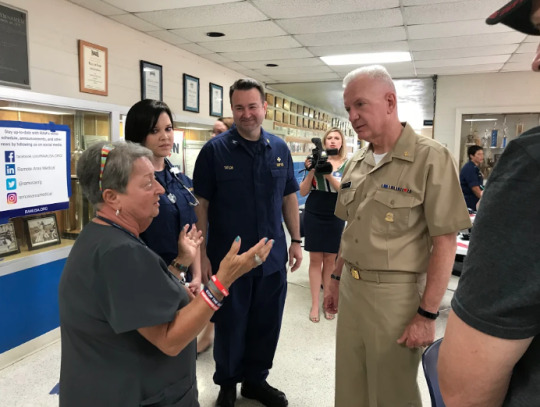
Photos courtesy of KXII and Kay Sisco
#adm. brett giroir#KXII Texoma#Rear Admiral Joan Hunter#Surgeon General Jerome Adams#RAM Oklahoma#durant ok#Southeastern Oklahoma State University#covid19#masks
0 notes
Text
Stan T-shirt unveiled at Chilhowee Park clinic!
At the recent Chilhowee Park clinic, RAM unveiled a new T-shirt design which features Stan flying his iconic C-47 (aka DC-3 or Dakota).

Kay Sisco was on the scene to get pictures of Sandra Sacco modelling the shirt, which was designed by Aaron Hinds, a member of the development team at RAM. Sandra is also a RAM volunteer. It includes Stan’s important words “Never Forget the Mission.” More on this in our latest blog!
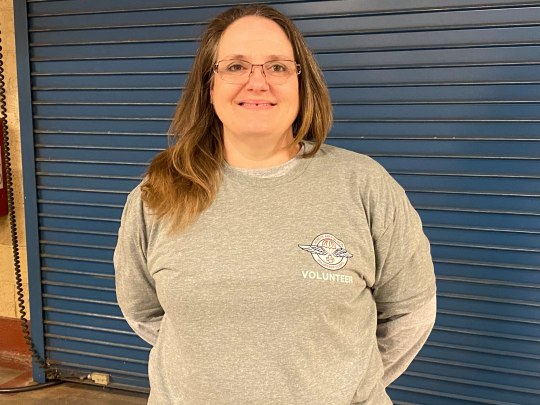
The clinic in Knoxville kicked off 2020 (Jan. 31st - Feb. 2nd) and was RAM’s Expedition number 1080. 1534 patients were served and 1267 volunteers were involved during three days in the Jacob Building.

0 notes
Text
Buster and Robert and Kay
Our casual correspondent Kay Sisco, core RAM volunteer, is back with a story from this weekend’s East Ridge TN 2019 clinic. Actually, it’s more of an update since the subject of her story is Buster, a service chihuahua who aids Robert, who has been turning up at Tennessee RAM clinics for years. Kay profiled the pair for us back in 2016.

Robert is prone to seizures, so he’s got Buster to warn him if a fit is coming … but also to jar him to attention if he’s having one. Kay first encountered Buster, nestled on Robert’s chest, at the 2016 Cookeville clinic. At that time, Buster wasn’t quite a year old - Robert usually gets his dogs while they’re very young. He’s not Robert’s first service chihuahua. Now he’s 4 1/2 and both Buster and Robert are now RAM volunteers! In fact they helped Kay set up at East Ridge on Friday!
Of course as in 2016, Kay (who took these photos and who’s a real dog lover BTW) got in her selfie with Buster too!

She also took these photos of Buster in dental with Robert, who’s wearing his Buster pouch and holding his pink form ...
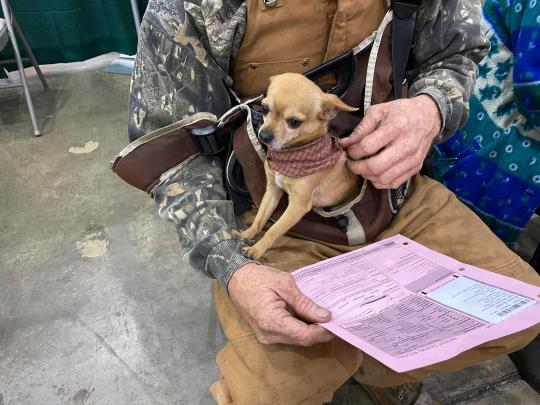
This one of Theo, who’s learning to be a therapy dog ...

And finally, it’s the end of the day on Saturday - which was a long, tiring day for Buster!

Goodbye y’all from Camp Jordan Arena! RAM’s next scheduled clinic is on December 6th in Suitland, Maryland at Beltway Church of Christ.
And Happy Thanksgiving!

#service dog#service chihuahua#RAM clinic#RAM East Ridge clinic#Tennessee#therapy dog training#Camp Jordan#Suitland Maryland#Beltway Church of Christ#Camp Jordan Arena#East Ridge TN#Happy Thanksgiving
0 notes
Text
The U.S. Rural Hospital Closure Crisis
It’s now known as “The rural hospital closure crisis”. On a steady closure trend even since getting national media headlines in 2017, the situation has become increasingly dire. According a 2018 report from the North Carolina Rural Health Research Program, of the 26 states that have seen at least one rural hospital close since 2010, those with the most closures are located in the South.


“Fourteen hospitals in Texas have closed since 2010, the most of any state. Tennessee has seen the second-most closures, with eight hospitals closing since 2010. In third place is Georgia with six closures, followed by Alabama, Mississippi and North Carolina, which have each seen five hospitals close over the past eight years.”
The Cecil Sheps Centre for Health Services Research at the University of North Carolina have issued a state-by-state breakdown of 108 rural hospital closures in 26 states, from Maine to California. The Sheps Center request people write in with information about new closures. https://www.shepscenter.unc.edu/programs-projects/rural-health/rural-hospital-closures/.

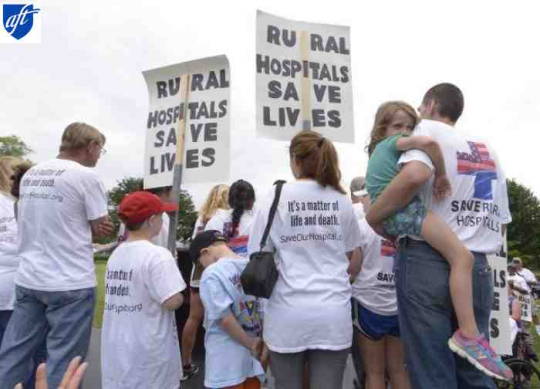
This is up from 98 in February 2019, as reported by the National Rural Health Association (https://www.ruralhealthweb.org/blogs/ruralhealthvoices/february-2019/rural-hospital-closures-rise-to-ninety-seven) which notes 700 more hospitals are at risk and with this risk, rural economies are as well:
“In rural areas, health care is so much more than what happens within the walls of a hospital or facility. Health care is the center of the rural economy, creating jobs and opportunities for residents, encouraging families to move to a county, and incentivizing businesses to open their doors. Without a rural hospital, a community will crumble. The most recent hospital closures will leave communities across the country without local care and will devastate rural economies nationwide.”

The NRHA has asked members of Congress to #SaveRural Hospitals and proposed H.R.3225 - Save Rural Hospitals Act - in 2015.
Remote Area Medical will do its part this weekend (August 3-4, 2019) to help address the increasing shortfall in rural care options when it partners up with the Making a Difference Foundation on a medical “mission” to Paonia, Colorado at #EnergyTech. Paonia is in western Colorado and has a population of 1,365 residents. The median household income is $37,330. Fourteen percent of the residents of Paonia live in poverty and 15.3% have no health insurance. There is one primary physician for every 1,243 patients and one dentist for every 1,291 patients.
https://allevents.in/paonia/2019-paonia-co-free-ram-clinic/200017313069413
#Cecil Sheps Centre for Health Services Research#Paonia Colorado#SaveRural Hospitals#National Rural Health Association#HRSA#remoteareamedical#ramusa#Paonia Clinic#Making a Difference Foundation
0 notes
Text
Chris Hall - photos from Wise!
Stan’s gone but Chris Hall isn’t. And they go back together quite a long time. RAM’s COO was recently featured in the Bristol Herald Courier ahead of the 2019 Wise Expedition starting soon - the big number 20! “When Chris Hall was 13 years old, his father encouraged him to volunteer at a Remote Area Medical clinic … At a clinic in a remote part of Tennessee, Hall recalls seeing someone get a pair of glasses for the first time.” #WarmingUpForWise20! See the Herald Courier feature at: https://tinyurl.com/y2366x44





1 note
·
View note
Text
Mountain Empire Airport Clinic 2018 Remembered
We’re fast approaching RAM’s 2019 clinic in Smyth County, Virginia, at Mountain Empire Airport this weekend, May 17-19. Much has changed since last year’s 'Expedition' - neither Stan Brock nor RAM Virginia are with us any longer, although the pioneering spirits of both live on. Stan’s imprint forever remains on RAM at large and former RAM VA head Vicki Weiss continues to volunteer for VOSH/International as well as maintain her own practice Weiss Eyes, Fluvanna Optometrists (with former RAMVA board member and husband Doug Weiss).
The 2018 RAM Smyth County clinic served over 764 patients and as many or more are expected this year. They will come from Smyth and many surrounding counties, from throughout Virginia and from other states. According to a WJHL Channel 11 report, roughly 11% of the population of Smyth County do not have health insurance.
Here's our Tumblr tribute to the 2018 Smyth County RAM clinic in pictures, starting off with one of Stan with Vicki and Doug.
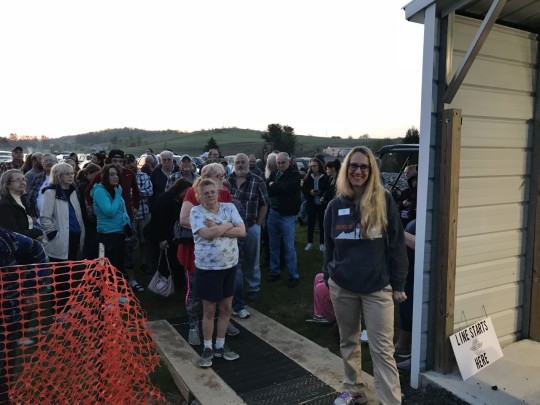



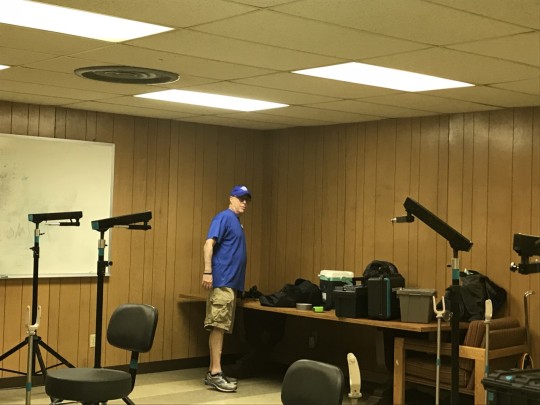
#Smyth County RAM#Mountain Empire Airport#Lee Highway#RAM Virginia#remote area medical#Stan Brock#Vicki Weiss#Doug Weiss#RAMSmyth2018
1 note
·
View note
Text
RAM Clinic 1000 in Chilhowee Park!
In early February, Remote Area Medical hosted its 1000th clinic at the Jacob Building in Knoxville’s Chilhowee Park.
Core RAM volunteer Kay Sisco was on the scene for Number 1000. She visited the Stan Brock memorabilia exhibition which ran in the building at the same time, which continued celebration of his life well lived - Stan died at the very end of August 2018. The exhibition featured a wide variety of items, including Stan’s first RAM logo drawings, photos from RAM Expedition Number 1 (Mexico) and much more! This was also 2019 Clinic #1.
So, photo essay time! Take it away, Kay ...



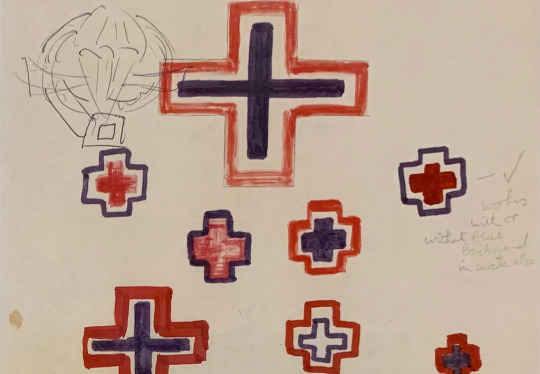


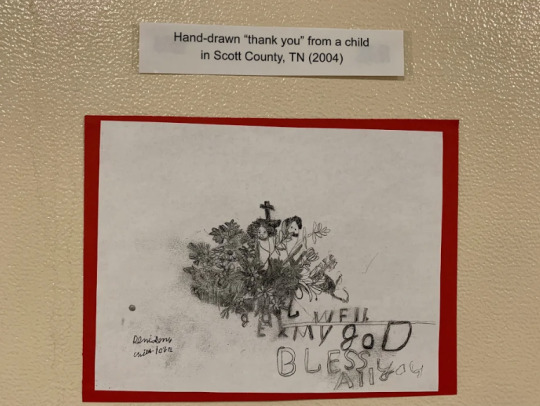
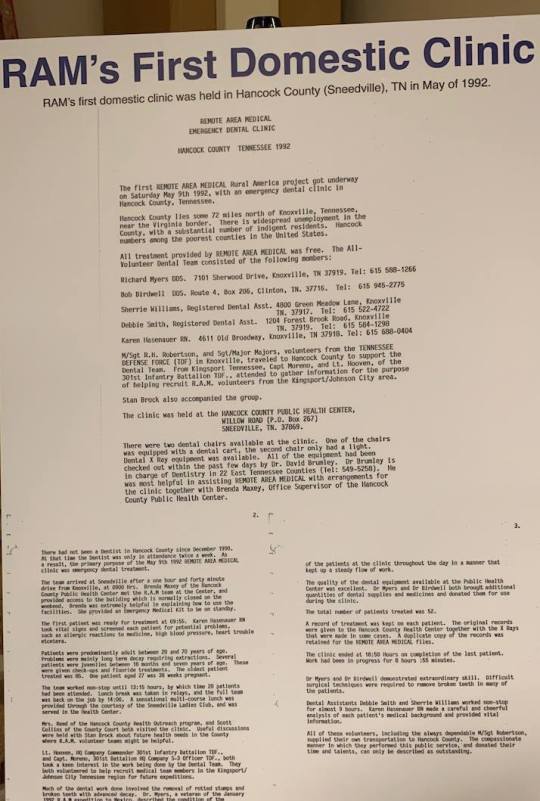
1 note
·
View note
Text
Across state lines in Ohio!
Good things in Ohio! In June we mentioned that the Ohio House had passed legislation to allow certain out-of-state licensed healthcare professionals to provide healthcare services on voluntary basis - during a charitable event - without obtaining a permanent Ohio license to do so. Stan Brock was very excited about this. At that time, and referring to RAM’s April Ohio clinic, Rep. John Patterson (D-Jefferson) and Sarah LaTourette (R-Chesterland) announced:
“HB 541 will help temporary clinics, like our recent effort in Ashtabula, to attract healthcare professionals outside our state by waiving their license fees during their period of voluntary service.”

RAM’s Ashtabula clinic served 953 in 2018 and aims to return in 2019. House Bill 541 passed out of committee unanimously and then through both chambers unanimously, with good bi-partisan support. 541 was finalized just over two weeks ago and passed on Thursday December 13th. And by clearing the state legislature this now heads to the governor’s desk!

Patterson added that out-of-state professionals can now practice in Ohio at a volunteer clinic and operate under Ohio’s health laws without paying a fee for an Ohio license.
“The theory was if we could waive those fees we could attract more providers.”
Ashtabula County Medical Center (ACMC), which celebrates its 115th anniversary next year and helped organize the April clinic which took place in Ashtabula Towne Square, announced:
“We would have been able to serve many more patients had we been able to recruit the physicians, nurses, physician assistants and nurse practitioners from outside of Ohio.”
With this news comes word that two more RAM free clinics are now being planned in addition to Ashtabula - one in Youngstown and another in the Dayton area.

According to Claims Journal, Ohio is only the fourth state to allow practitioners to cross state lines - Tennessee was the first in 1995 when its legislature passed the Volunteer Healthcare Service Act, thanks in great part to Stan’s campaign efforts. While much later campaigning for the Healthier Act, an initiative organized in collaboration with Rep. John J. Duncan Jr. (R-Knoxville), Stan said: “We have no problem at all getting volunteers … if they are allowed to cross state lines.”

US doctors sit the same national exams but the practice of medicine across state lines has been beset by multiple issues despite a number of organized schemes such as the AMA’s Interstate Medical Licensure Compact. This has not featured robust uptake thus far. And to confuse things further, there is a different compact for dentistry which Stan pushed for: the Coalition for Modernizing Dental Licensure (https://www.dentallicensure.org/en) was founded by the American Dental Association, the American Dental Education Association and the American Student Dental Association. For vision it is even more complicated, with ophthalmologists and optometrists organized through other associations.
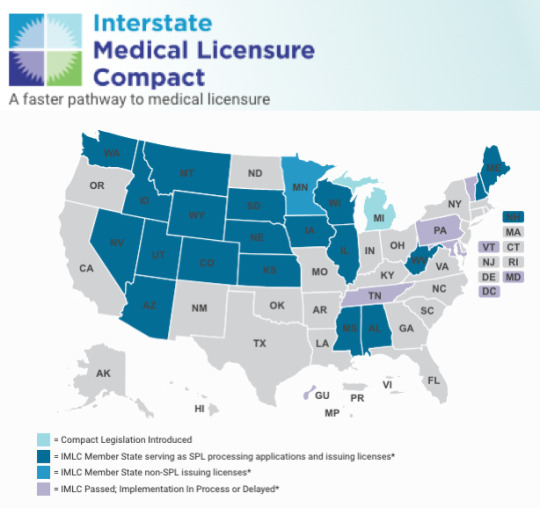
The AMA last year claimed that cross-state licensing process via the IMLC was live in 8 states (https://www.ama-assn.org/practice-management/digital/cross-state-licensing-process-now-live-8-states) but states such as Ohio (via HB 541) have adopted their own legislation to more effectively expedite volunteering across state lines. Whereas the IMLC seems to have become bogged down among several reform models and lack of consensus, according to 'The Traveling Doctor: Medical Licensure Across State Lines’, a seminal article written by Brittany La Couture for American Action Forum. (https://www.americanactionforum.org/insight/the-traveling-doctor-medical-licensure-across-state-lines).

The strength of state medical boards and their pull for share of fee-based profits looks to have forced ad hoc state bills for volunteer events (like Ohio, or Tennessee in 1995, Illinois, or in California two years ago) and now more recently Healthier Act candidacy. In the case of the latter, there’s now grant money for states which pass laws allowing out-of-state health care providers to offer services on a volunteer basis.
***
NB: On December 21, 2018 Ohio Governor John Kasich signed Sub H.B. 541 (Patterson, LaTourette) into law. This was one among 14 bills. See: https://governor.ohio.gov/Media-Room/Press-Releases/articleid/1063/kasich-acts-on-14-bills

#MedicalLicensure#StateLines#RenoteAreaMedical#AshtabulaOhio#StanBrock#HealthierAct#Interstate Medical Licensure Compact#American Action Forum
0 notes
Text
LOOKING BACK ON RAM WISE 2018 • by Heather Canady Rhodes

Wise County, VA - Very early Thursday morning starts off just like every other morning in coal country. People going about their normal blue collar lives, getting ready for work in the coal mines just like their fathers and grandfathers have done for years. Everyone except a couple of dozen families. These families are setting up tents to camp in for the weekend at Wise Co. Fairgrounds. Why you ask… Remote Area Medical is holding its 19th annual clinic this weekend. These families know to makes sure to get there early for the free medical dental and vision care that RAM and the Health wagon provides. Only a specified number of patients will receive the care they so desperately need.
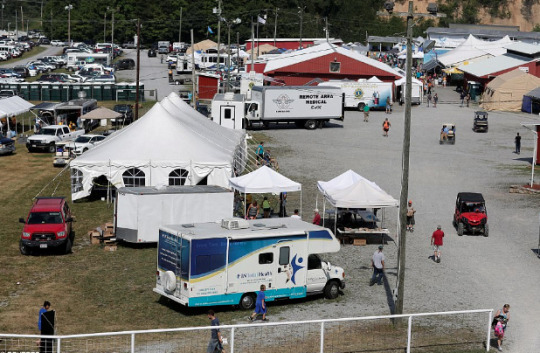
THURSDAY 10 AM. Trucks start rolling into town. These trucks are filled with all the equipment and supplies that are needed for the clinic. Volunteers are there to help set up a 40 chair dental clinic, a 7 lane vision clinic and a 45-50 bed medical clinic. Volunteers work nonstop until each and every station is perfect and ready for patients. They finally finish setting up about 5pm.

They have taken a small county fairground and turned it into a fully functioning clinic, complete with cardiovascular services, pulmonary services, vaccinations, women's health, plastic surgery, and much more. They have worked hard but know the real work has yet to be done. The real work will start at 5 am for hundreds of volunteers.

FRIDAY 5AM. Clinic Day 1 rolls around and volunteers start showing up by the car full, still rubbing the sleep out of their eyes, coffee in hand, and eager to start the day. Volunteers are assigned to each department of the clinic, everything from trash pick up to patient check out. There is no unimportant job at s RAM clinic. Each and every volunteer provides a unique service the clinic requires to run smoothly.
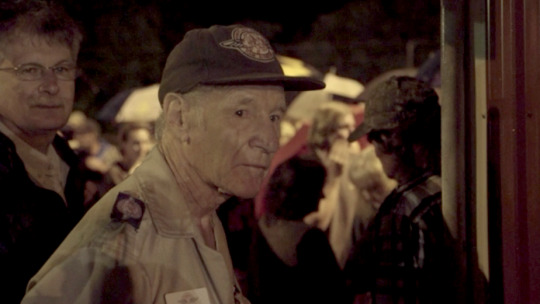
FRIDAY 6AM. The fairgrounds gates are opened by Stan Brock and numbers start to be called. One by one patients are escorted to registration and then to triage to have some vitals taken and blood sugar levels checked. From triage they head to the services they need. The clinic only shuts down after all the patients have been seen.

The same scene repeats itself for the next 2 days. Roughly 1500 people are seen and over $400,000 worth of care is given, all for no charge.
SUNDAY, RAM Wise Day 3. Looking around the fairgrounds bustling with patients you can help but wonder why these people have waited all night in long lines all day for care. These are our friends, family members and neighbors. They are working people; surely they can get to s doctor or a dentist or an optometrist. Perhaps they can but the cost not covered by insurance is so high that most simply can’t afford to. It becomes a choice between medication and paying the light bill or buying groceries for the week. These are everyday people just like you and me.


Sunday evening rolls around and it’s time to go. The trucks pack back up and head to Knoxville where they will resupply for the next town in need. As the Wise County Fairgrounds clear off, you’d never know what has gone on this past weekend in a small quiet town in Appalachia, Virginia.

Heather Rhodes, author of this blog and pictured above with ‘Medicine Man: The Stan Brock Story’ Director Paul Angell and DOP Tom Goudsmit at Wise, is RAM Virginia’s On-site Volunteer Coordinator, and was part of the Med Man Virginia task force for our Tri-State shoot. Her assistance was invaluable. Thanks also to RAMVA’s Candy Hall for the dental photos used above, which she took at Wise, and to Matthew Sutherland for the aerial image taken over the County Fairgrounds site.
#RAM Virginia#remote area medical#ram wise#Wise County Fairgrounds#Wise County Clinic#The Health Wagon#Stan Brock
1 note
·
View note
Text
We’re back!
Medicine Man: The Stan Brock Story is filming this week (July 17th forward) in North Carolina, Tennessee and Virginia. We reprise our visit to RAM Wise in 2015 with the same team (Paul Angell and Tom Goudsmit) who've worked other clinics such as East St Louis.
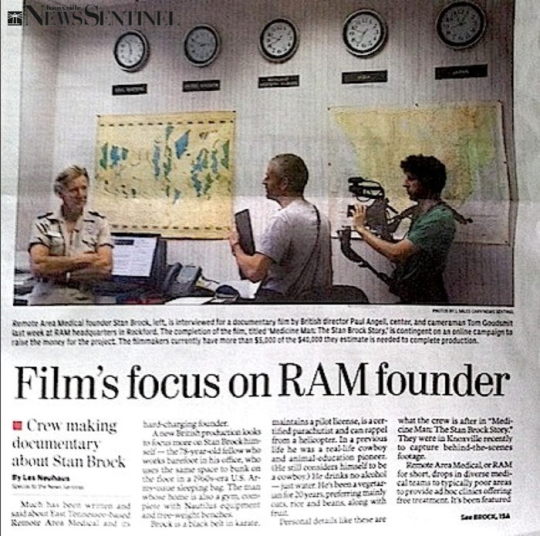
And we need you! The film team is keen to meet up with families planning to go to Wise. From Director Paul Angell:
Hello there,
I'm the director of a feature-length documentary about the life of Stan Brock entitled Medicine Man: The Stan Brock Story
www.medicinemanstanbrock.com
Stan Brock is the founder of Remote Area Medical - RAM, who helps to run the free healthcare clinic at Wise County Fairgrounds every year.
If you and your family are planning on going to the RAM Wise clinic this year (20-22 July), we would really like to hear from you.
Our filmmaking team went to Wise in 2015 and filmed Dr. Teresa Lynn Tyson, Dr. Paula Hill-Carson & Dr Joe Smiddy of The Health Wagon, as well as many of the patients. We are returning to Wise this year and would love to hear from any families that are going. Or perhaps you might know a family that are planning to go?
Please PM us here on Facebook or email at: [email protected]
You can also send us a Twitter DM or notify us on Instagram: instagram.com/medicinemanstanbrock, though we don't check it as often as we'd like. We're currently not checking messages on our website. But if you do respond, be sure to leave a reliable way to get in contact during the clinic.
Many many thanks for your time and for helping us to get this important documentary feature film made.
Paul Angell

0 notes
Text
The Tennessee Lions Low Vision Rehabilitation Project • by Cheryl Saucier
Work the Lions Club does for vision and in particular LOW vision across the US, from coast to coast, is getting praise. No less so in Tennessee where the Lions have worked with Remote Area Medical for several years now. The Tennessee Lions Low Vision Rehabilitation Project recently completed a RAM-assisted clinic in Athens, TN and next month hosts another in Columbia TN. Practice Director and Low Vision Therapist Cheryl Saucier explains what it’s all about in our latest Guest Blog!

Hi, I’m Cheryl and I am the project manager for the TLLVRP (role I serve as a Lion and volunteer) and the practice director for Southeast Vision Rehabilitation, a specialty low vision optometry practice. TLLVRP is a three-year old endeavor that seeks to improve access to high quality rehabilitative care for individuals with low vision in our area.
But who are we?
The Tennessee Lions Low Vision Rehabilitation Project is a collaborative effort between Lions Clubs volunteers, low vision medical providers, and community organizations to serve individuals with low vision through community service, education, research, and advocacy.

In late 2016, TLLVRP were awarded a grant from Lions Clubs International Foundation to help us with our work. Part of our mandate for the grant is to find ways to reach unserved and underserved people with vision loss and connect them with rehabilitative care. As we sought ways to do this, we met Lion Mary Brown and were introduced to Remote Area Medical. We went to Maryville and talked with RAM staff about our project and asked if we could set up a table at a clinic to see if we could identify and help patients with low vision who may be seeking help for eye exams and glasses.
Our first RAM clinic was in Red Bank High School of Chattanooga, TN in 2017 (https://www.tnlionslowvision.org/blog/red-bank-remote-area-medical-clinic). In total, we have participated in 5 RAM clinics including Red Bank, Athens (2017), Camp Jordon, Cookville, and Athens (2018).

We work with the volunteer ODs and OD students to send any patient who meets the criteria for low vision to our table. At this point we provide basic low vision aids - both optical and non-optical -- and then refer these patients to the free state service for people with vision loss for ongoing assistance. Our table is also visited by volunteers and other patients who have questions about loved ones.

The demographics of RAM patients are consistent with the numbers of people we reach at any given clinic. In other words, most vision loss occurs as a result of aging. RAM patients span a wide range of ages. From what I have observed, the majority of RAM patients ARE NOT seniors - say aged 70 and older. At each clinic we see a handful of patients - 8-15 who need some assistance.

After five clinics, our involvement with RAM has helped us accomplish 3 of our grant-related tasks:
1) Human Resources Training. Our low vision doctor, Dr. Heather McBryar has been present at 4 out of 5 of these clinics. She does some training with the OD students in that clinical environment. The OD students learn about resources for low vision patients as well.
2) Low Vision Awareness. We disseminate information to anyone who stops at our table. Patients, family members, and volunteer providers all stop by our table and talk with us about low vision and what we can do to help.
3) Assist underserved and unserved people in our area who have low vision and no other way to access care.

We are currently in talks with RAM staff about ways to insert low vision assistance into their model permanently. Our project plans to attend the following upcoming RAM clinics - Columbia TN, July 14-15, Fentress CO TN, September 8-9.
If you’d like more information about our project, as a patient or a volunteer, please visit our website at https://www.tnlionslowvision.org/
Or give us a call on (423) 521-2863

0 notes
Text
The Kay Sisco Photoblog: U.S. Surgeon General visits RAM Oklahoma in Durant!
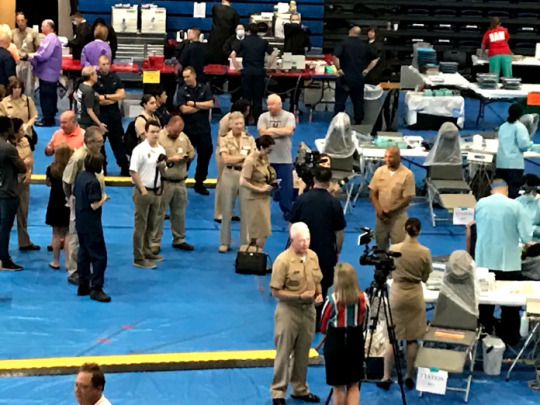
U.S. Surgeon General Dr. Jerome Adams was in Durant OK on Sunday for a first-hand visit to the RAM clinic at Southeastern Oklahoma State University #SEOSU. Adams is the 20th Surgeon General of the US, sworn into office by Vice President Mike Pence on September 5, 2017.

Like Pence, Adams is a Hoosier - he’s a board-certified anesthesiologist who served as Indiana State Health Commissioner from 2014 to 2017, and remains an associate professor of clinical anesthesia at Indiana University School of Medicine, among other positions. As reported by Oklahoma ABC affiliate KTEN, Adams was impressed by RAM’s Durant clinic and had this to say:
"For me, it's not just about the care... it's about the caring.”
"There's gaps, and there always will be, so it's important for volunteers to fill in those gaps, particularly for those most at need.”
Volunteers like Kay Sisco who often photo blogs for us, is a super RAM stalwart, has taken or has organized the taking of all of these photos, and notes:
“I met Surgeon General Jerome Adams Sunday in Durant OK! He grabbed my phone and took this selfie! Super nice gentleman!”
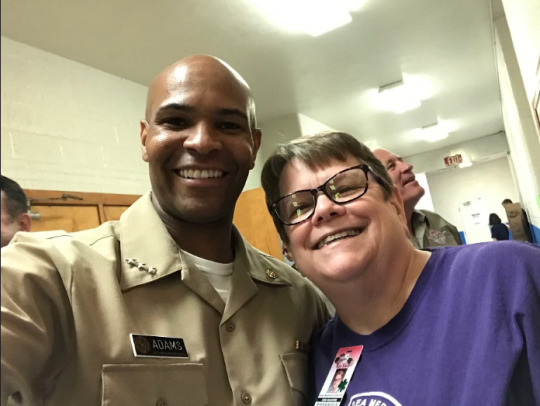
Adams was joined by Assistant Secretary for Health Admiral Brett Giroir, who is in Kay’s photo below with RAM Triage Lead Mary Ann Comparoni.

Giroir noted:
"Walking through here, you just cant help but touch your heart, touch you very, very, deeply … What I see is a community, a non-profit organization, and the U.S. Public Health Service coming together to really care for people."
Adams and Giroir were joined by Deputy Surgeon General Sylvia Trent-Adams (no stranger to RAM clinics), pictured here with Kay!

Rear Admiral (RADM) Joan Hunter, director of the US Public Health Service (PHS) Division of Commissioned Corps Personnel and Readiness, was also on hand with USPHS violunteers.

The priority of the USPHS Commissioned Corps is to serve underserved populations, is actively involved in re-establishing community health and service missions, and partner with Remote Area Medical. Kay captured this photo of RADM Hunter with Stan Brock and RAM COO Chris Hall listening to a talk on the opioid epidemic and how to eliminate them!
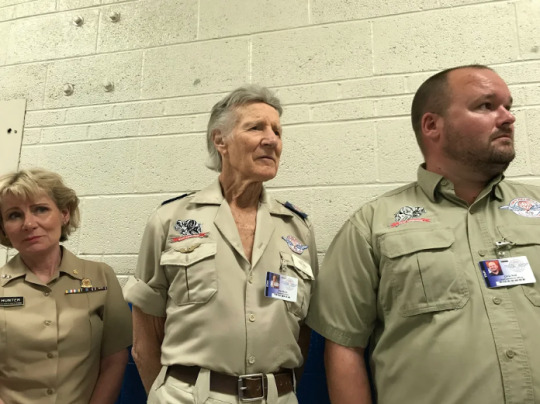
As for the Surgeon General, he left Durant with these words:
"It's the first time I've been here, but it won’t be the last," Adams said. "I am blown away by what I've seen."

#USPHS#surgeon general#rear admiral#deputy surgeon general#USPHS Commissioned Corps#Durant OK#US Public Health Service#RAM Oklahoma#Assistant Secretary for Health#Kay Sisco
0 notes
Text
Kay Sisco at Ashtabula!

Core volunteer Kay Sisco flew in to assist at RAM’s first-ever clinic in Ashtabula. Ohio, a three day affair held near the shores of Lake Erie. Besides her usual hard work in registration, Kay took some clinic photos for us.

Over 900 people attended. The venue was an old Dillard’s store in the Ashtabula Towne Square mall.
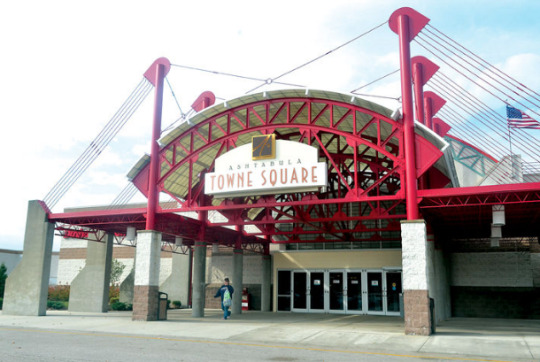
Wonderful, large number of eager volunteers! Here’s volunteer check in with RAM shirts in background!

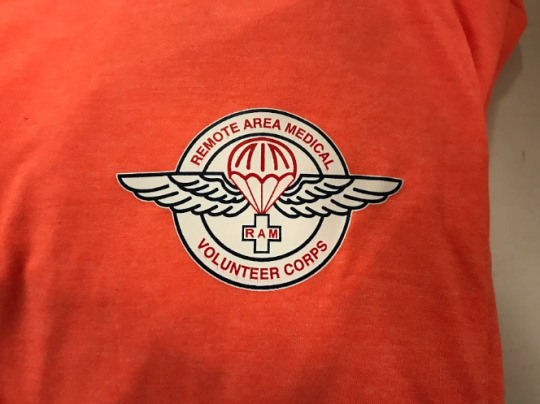
Here’s everything else Kay saw in pictures - first the prep and then after doors opened.
Leading off in vision: vision chart, glasses frames and vision section … all ready to go!



For Dental: dental trays, dental X-ray, sterilization, and dental instruments … all ready to go!


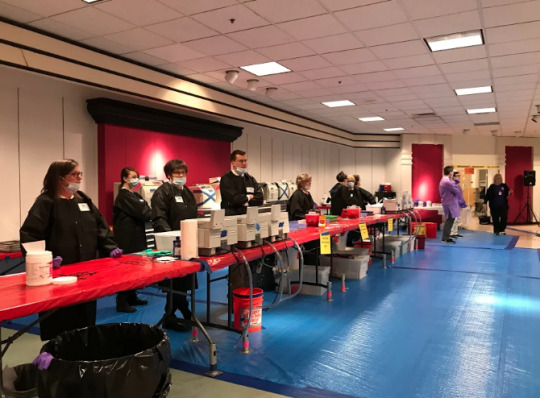

Doors have opened and first patients are in. 60 dental chairs and the “bucket brigade”


Kay visits with some of the clinic practitioners/volunteers! These include Dave Maurer RN Medical lead, Poppy Green clinic coordinator, Elizabeth Larwood in Dental X-ray, and in the final photo, it’s Linda Nelson (Dental), Bill Slover (Vision), and Emily McGee (Development).

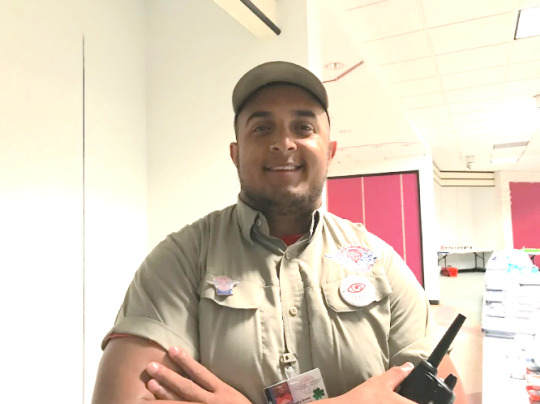


2 notes
·
View notes
Text
#RAM900 - photoblog by Kay Sisco
EDITOR’S NOTE:
A look back at the recent Number 900 five day clinic (Jan. 31 - Feb. 4) at the Jacob Building, #ChilhoweePark, South Knoxville - in pictures! RAM core volunteer Kay Sisco took these across various days, when she was able to get away from her work in patient registration - 1865 registrations!
Hi, I'm Kay and I'm a volunteer at this year's amazing number 900 clinic at Chilhowee Park in South Knox. We're in Day 5 and what an incredible - and unprecedented - expedition. I took as many photos as i could from a bird's eye view - photos from the upper terraces just to give you an idea of the sheer scale of the Jacob Building and the event taking place in it. And what a fabulous 5 days in South Knoxville.
The first two images are of dental waiting and dental care ...


Here are two “before and after” shots paired up for contrast! Before doors opened and after - in Triage!

Back on the ground floor, it was great to have volunteers from Human Animal Bond in Tennessee (H.A.B.I.T.), a program of the UTCVM-University of Tennessee College of Veterinary Medicine. HABIT sponsors animal-assisted therapy programs in a variety of settings with the help of a strong core of volunteer pet owners and their pets. HABIT came to RAM's Chilhowee Park #900 clinic with dogs like Judge, pictured below, as comfort for patients. Dogs rotated in and out.
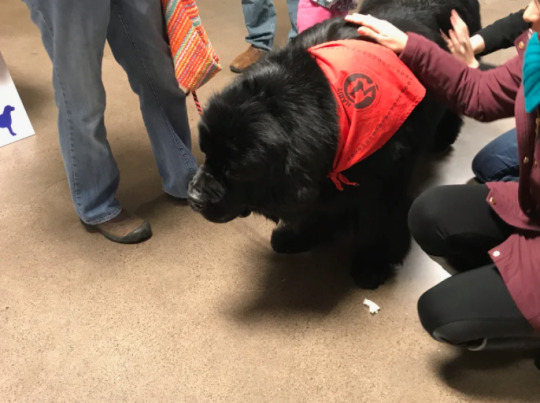
Another cute HABIT pup!

RAM Clinic # 900 was historic in Knoxville TN. This 5-day clinic held at the Jacob Building at Chilhowee Park saw just under 1,900 people register for over a million $$ in free dental, vision and medical services. Volunteers from across the country and Puerto Rico came together to staff this historic clinic. In a few instances thankful patients returned to volunteer at Chilhowee Park and to give back and help others. Pictured below: Dr Gloria from Puerto Rico.

Stan Brock even got the red carpet rolled out for patients because - as he himself said - "... it will serve as a unique reminder that RAM patients are equally as valuable as the highest-paid and tremendously regarded celebrities in Hollywood."
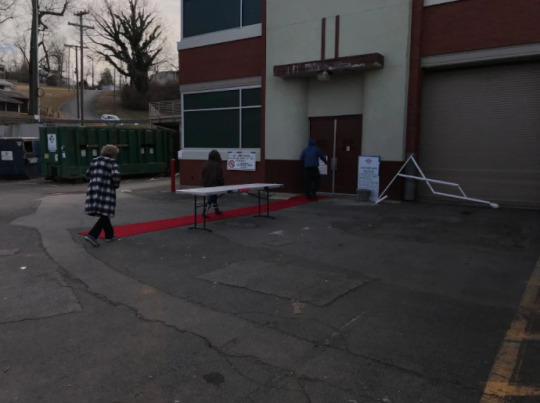
I hope you enjoyed my perspective! Let’s finish off with a photo of Stan addressing the core volunteer group after the clinic wrapped on February 4th! Best regards, Kay

0 notes
Text
Why are so many Americans crowdfunding their healthcare?
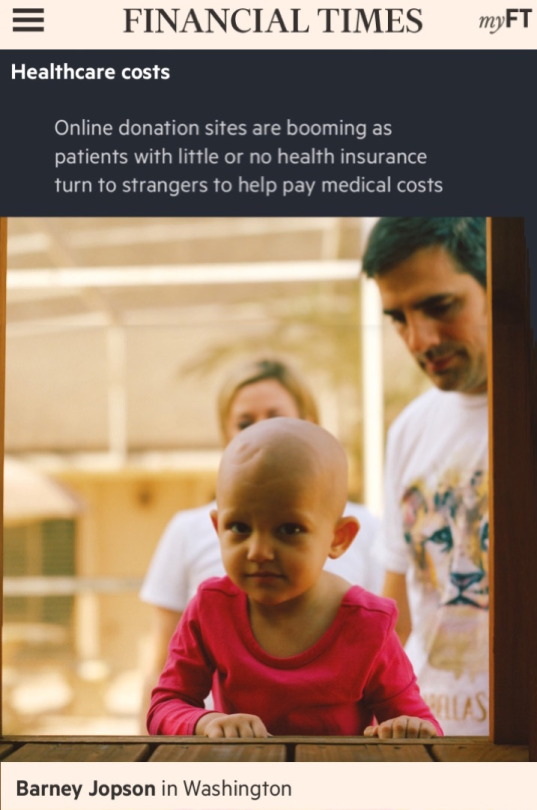
Reposted from the FT • 11th January 2018 •
Isabella Masucci strode into hospital after a sleepless night. She carried a paper bag of prized possessions and bore two meandering scars on her hairless head. Instead of the princess dress she had wanted to wear, she was dressed in a T-shirt and pink leggings. They enabled easier access to the tube that hung down from a catheter under the skin of her chest, allowing doctors to load the toxic drug Dactinomycin into her heart. It was close to her 50th day of chemotherapy. Isabella is two years old.
Ten months earlier, after she began to experience balance problems and bouts of vomiting, a CT scan revealed she had brain cancer. Surgeons removed a tumour the size of a golf ball. Then came radiotherapy and chemotherapy. Now Isabella was back at a Florida hospital for more. She knew where to go, what to do, who she would see. “Dr Smith, Dr Smith,” she chirped as she walked towards the children’s cancer centre. Every so often she dropped her bag, scattering toys across the floor.
There to pick them up were her weary parents. For Claudia Koziner and Darren Masucci, the past year has been brutal. Each chemotherapy cycle begins with their daughter’s screams as a needle is jabbed into her chest. Once the treatment is over, she often succumbs to fevers and infections. They sleep for nights on end at the hospital.
Then there is the issue of money. In the US, where healthcare is not a human right, any serious illness comes with a financial shock. The average cost of hospital stays for cancer patients in 2015 was $31,390, according to government figures — about half that year’s median household income. The most common form of childhood cancer costs on average $292,000 to treat, says St Jude Children’s Research Hospital in Memphis, Tennessee.
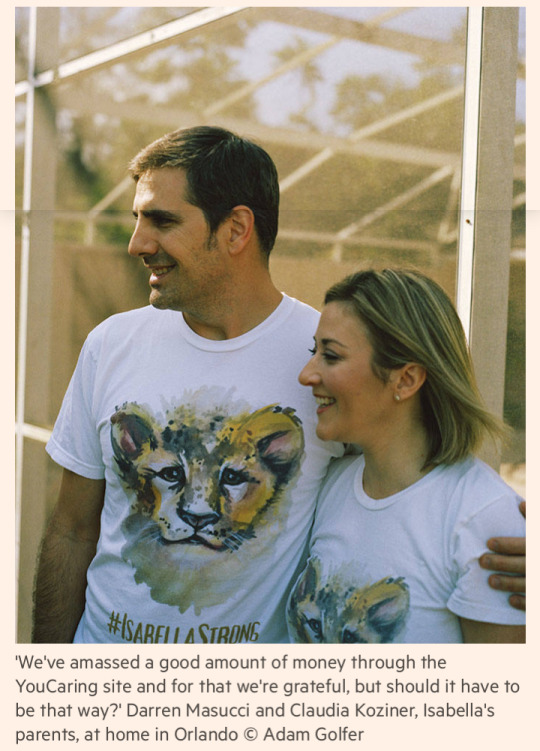
For the most fortunate Americans, these costs are covered by comprehensive insurance plans. For millions of others, they are a potentially crippling burden. After Isabella’s diagnosis, Koziner took unpaid leave to care for her daughter, reducing the family to a single income. She and Isabella were able to stay on the health plan provided by her employer, ensuring they did not join the 28 million Americans who lack any health insurance. Instead, they are part of a larger group that is underinsured. The family pay $15,000 each year as part of cost-sharing arrangements with the insurer, then have to cover everything it will not, ranging from protein shots to hearing tests to two-way ambulance trips that can cost up to $3,000.
Koziner’s retired parents offered to sell their house to raise funds, but the couple said no. Friends urged them to ask other people for help. “We were very sceptical,” says Koziner. “People are weird with money.” Eventually they relented — and joined the thousands of US families that have turned to online crowdfunding to help pay for medical costs. They had no idea what they would raise. “I was thinking 10 grand,” Masucci tells me. In fact, as Koziner says, “We made 20 grand in like a day or two.”
The total has now reached $109,245. Their page on YouCaring, a platform for fundraising for personal causes, has attracted 9,000 shares on social media and more than 1,000 donors. The money has come in tens, twenties, hundreds of dollars. Koziner has seen donations from alumni of her high school in Argentina. A woman from Dubai broke away from a trip to Disney World to deliver toys and essential oils to them in hospital. “A lot of the time we don’t know who these people are,” Koziner says.
They are not alone in relying on the kindness of strangers. YouCaring has helped its users raise more than $900m since 2011 and its momentum is building, with roughly $400m coming in over the past year. The company says close to half of its 350,000 active campaigns are related to healthcare and the fastest-growing category is fundraisers for cancer.
For Isabella and her parents, crowdfunding has alleviated financial pressure at an agonising time. “The fact that at least, at this point in time, we don’t have to stress about finances is huge,” says Koziner. “I don’t even know how we’d get by.” But its spread is also a symptom of a particularly American affliction: a flawed, costly healthcare system that offers some of the best care in the world to those who can afford it, while forcing millions of others to either plunge into debt or leave their illnesses untreated.
The rise of online fundraising for medical expenses brings its own troubling consequences, replicating some of the inequalities already dividing the country by forcing people to compete for funds.
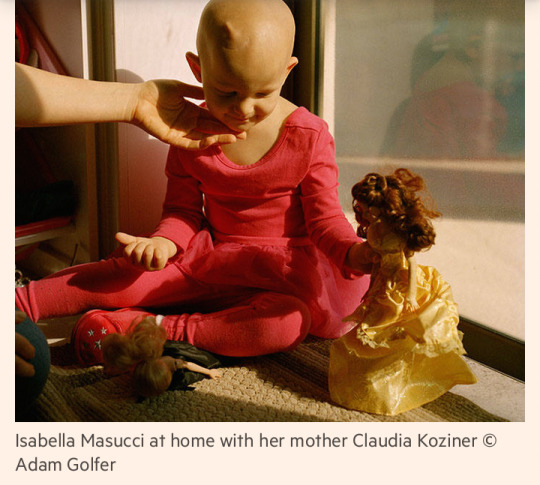
“I remember the day we launched the YouCaring site. For me it was devastating,” Koziner says. “Because now the world knew that my daughter had cancer. You’re not just asking for money. You’re telling people what’s wrong.” Masucci says they had ended up stepping over boundaries they would have never imagined crossing. “So we’ve amassed a good amount of money through the YouCaring site and for that we’re grateful, but should it have to be that way?”
------
Online crowdfunding began in the late 1990s as a way for musicians and film-makers to raise money from fans. Within a decade it had begun to take hold for personal causes. The founders of GoFundMe, the sector leader, initially envisaged helping users pay for holidays and weddings. But by 2009 they began to notice people were using the site more to cope with crises, including medical emergencies. They embraced the trend. The company now calls itself “The World’s No.1 Site for Medical, Illness & Healing fundraising” and says it has raised $5bn for users globally since 2010.

It should be no surprise that healthcare proved fertile territory. Crowdfunding is also growing in the UK, Australia and Canada but is generally confined to treatments not covered by public healthcare systems. In the US it is often about paying for the basics. American medicine is big business and the US spends more on it than any other nation, yet it is the only developed country that lacks universal healthcare coverage. A fifth of US household spending went on healthcare in 2013, compared with just 4 per cent in the EU, according to Eurostat, a statistics agency.
Despite this, Americans are in worse health. Judged on measures including life expectancy and infant mortality, the US ranked last for healthcare outcomes among 11 high-income countries in a study last year by the Commonwealth Fund, a New York-based research foundation.
The medical-industrial complex, shaped by decades of policy grounded in a belief that private is better than public, is as vast as it is incoherent. For many patients, it is synonymous with dysfunction and unmanageable expense. According to a Gallup poll last December, 72 per cent of Americans believe the US healthcare system “has major problems” or is “in a state of crisis”. The strains are all too apparent. From 2005 to 2013, medical bills were the single largest cause of consumer bankruptcy in the US, according to Daniel Austin, a Northeastern University law professor.
“Who among us hasn’t opened a medical bill or an explanation of benefits statement and stared in disbelief at terrifying numbers?” asks Elisabeth Rosenthal, a physician-turned-author, in her 2017 book, An American Sickness. “It is easy to feel helpless.” Sites like GoFundMe and YouCaring offer the chance to regain some control. Their pages reveal campaigns for people facing strokes, leukaemia, Lyme disease, kidney transplants and muscular dystrophy. There are limbs lost, bones shattered and organs ruptured in car crashes and mountain falls and shootings.
It is on YouCaring that I find Yesenia Rosa, 34, an Orlando school teacher. She arrives to meet me holding a folder bulging with papers. When she opens it, medical bills slide out across the table. The first is a $722 charge for the biopsy last March that confirmed she had stage 2 breast cancer. “I was devastated,” she tells me.
She stopped working to cope with her treatment, and her school’s IT officer set up a crowdfunding campaign for her. For a time, the law required her employer to keep paying for insurance that covered core medical costs, including $111,578 for a round of chemotherapy. When that phase ended, Rosa had to cover the $906 monthly premium herself, a sum roughly equal to her rent. “If I don’t keep paying, they’ll cancel me the next day,” she says.

Other invoices on the table — for anaesthesia and a plastic surgery consultation related to her mastectomy — were not covered by insurance. Rosa is resigned to being pursued for the money by debt collectors. But crowdfunding, which has yielded $2,787 towards her $5,000 goal, has at least enabled her to keep her insurance. “It’s one quick way that everyone can help instantly,” she says.
Rob Solomon, GoFundMe’s chief executive since 2015, says his company is using social media to break up the old fundraising monopoly of traditional charities. “This notion of democratising campaigning is when the light bulb went off in my mind,” he tells me. “I said, ‘Wait a minute. This is the disruption. This is the transformation.’”
It is tempting to see crowdfunding as a new brand of philanthropy, filling holes left by the shortcomings of profit-driven healthcare. But it is not that simple. Crowdfunding is not the antithesis of the market. It is competitive in its own right — a sympathy market where sickness is on sale.
-----
Claudia Koziner becomes tearful when I ask about her candid posts on Isabella’s health and her own emotions. “I have historically always been a very private person and my family’s always been very private,” she says, her voice cracking. “I’ve never been one to share too much with strangers.” Privacy is one thing successful fundraisers have to sacrifice. YouCaring advises campaign managers to think about which parts of their stories will “generate empathy”; to offer specific details and personal reflections; to post high-resolution photographs; and to provide regular updates.
Koziner understands what works. She has broadcast Facebook Live videos from the hospital and ends her frequent posts with tweetable hashtags such as #isabellastrong. “I don’t put everything, honestly,” she tells me. “You have to balance a little bit of the fun, the happy, the silver lining, because if not it’s too depressing.”
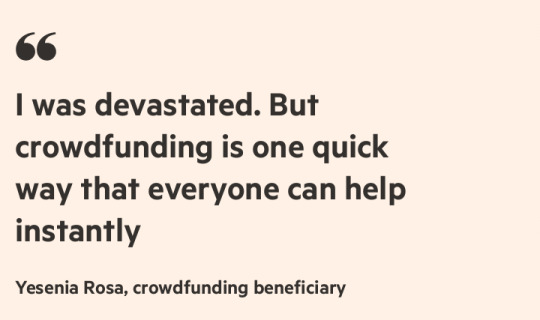
Others are uneasy about the demand for self-marketing. “You have to kind of make the appeal that you are a worthy subject for donations. It’s the commercialisation, the commodification of your illness,” says Jeremy Snyder, an associate professor at the Faculty of Health Sciences at Simon Fraser University in British Columbia. The business of healthcare turned the sick into consumers. Now crowdfunding is turning patients into products.
Not every product finds a market. Academics at the University of Washington Bothell who studied 200 GoFundMe medical campaigns found that nine out of 10 did not meet their goals, which ranged from $310 to $100,000. They netted on average just over 40 per cent of what they were seeking. Seven raised nothing at all. Last November, Bernie Sanders, the former Democratic presidential candidate, highlighted the story of a diabetic, Shane Patrick Boyle, who died after his GoFundMe campaign to pay for insulin reportedly fell $50 short.
Bioethicists have long wrestled with how public healthcare resources should be allocated when there is not enough for everyone. There is a loose consensus on the need to consider the cost-effectiveness of treatment, the gravity of patient needs, and individual financial circumstances.
There is no argument for distributing funds according to who is most telegenic. But that is what crowdfunding sometimes does. Daryl Hatton, founder of several businesses in the sector including FundRazr, views this as unavoidable. “Life’s not fair,” he says. “People will have these challenges and conditions even when they’re not attractive, they’re not the most fundable. It’s a bit of a popularity contest and there’s not much you can do about that.”

While crowdfunding platforms allow anyone with an internet connection to tell their story, there is no guarantee their message will be heard — or that it will resonate with funders. “People come at this thinking that [a successful campaign] is just about telling a really sad story or having a really tragic event,” says Nora Kenworthy, one of the University of Washington academics. “But we found plenty of really sad stories that weren’t getting any funding or were getting very little.”
Campaigns tended to do well when patients had discrete medical problems with comprehensible cures. Less successful were calls for help with terminal illnesses or chronic conditions such as heart disease, which did not carry the promise of a happy ending.
Crowdfunding may also perpetuate existing inequalities. Well-off people can tap into networks of well-off friends who have money to donate in a crisis. Poorer people tend to have ties to poorer people with less to give. Kenworthy and co-researcher Lauren Berliner warn that results can also be distorted by prejudicial notions of “deservingness” based on race, class and immigration status. “Crowdfunding seems to be best for people who are of a dominant social group who have fallen on hard times,” Kenworthy says.
----
To understand how people in one of the richest countries in the world ended up competing for healthcare funding online, it is instructive to listen to a Ronald Reagan recording from the early 1960s. A Hollywood celebrity moving into politics at the time, he spoke as Democrats were pushing to create a government medical insurance plan for the elderly, dubbed Medicare. Reagan tore into the proposal as “socialised medicine”. If Americans did not persuade Congress to reject it, he said, “behind it will come other federal programmes that will invade every area of freedom as we have known it”.

Reagan was voicing fears that have restrained federal involvement in healthcare since the Depression era. Healthcare industry lobbyists have played a central role in fostering the belief that the government should be kept at bay. Reagan had in fact recorded the message for the American Medical Association, a lobby group for doctors, which sent copies to physicians’ wives as part of its campaign to drum up opposition to Medicare.
“Physicians were very concerned that any [government] financing arrangement would bring control over their fees,” says Paul Starr of Princeton University, a leading healthcare historian. The AMA lost the Medicare fight, but in the past century the industry has defeated a series of other proposals for universal national insurance plans.
That clout has endured. No business sector, not even Wall Street, has shelled out more on lobbying than pharmaceuticals and health products. From 1998 to 2017 it spent $3.7bn influencing policymakers, according to the Center for Responsive Politics. Physicians have also preserved their generous earnings. Jobs in medicine and dentistry accounted for nine of the 10 highest-paying roles in America in 2016, according to Forbes, with anaesthesiologists earning an average salary of $269,600, surgeons $252,910 and family doctors $200,810.
The success of lobbyists partly explains why American spending on healthcare was worth 17.2 per cent of gross domestic product in 2016, according to the OECD. The second-highest figure was Switzerland’s 12.4 per cent; Britain came in at 9.7 per cent. “We’re somewhere close to the limit of what society can comfortably spend,” says Zeke Emanuel, an influential oncologist, academic and an architect of the 2010 healthcare reforms brought in under Barack Obama.

By the time Obama became president, voter frustration with the system’s dysfunction was such that the industry decided it had to support his push for change in order to influence it. Obamacare’s signature achievement was to reduce the number of uninsured Americans — but in doing so it cemented the primacy of private insurers.
The reforms were also meant to contain costs but their achievements on that front have been modest. Hospitals still have free rein to set prices for everything from urine tests and MRI scans to hospital gowns, and the bills keep ratcheting up. Most medical teams continue to get paid more for doing more, so they are incentivised to order procedures that are duplicative, unnecessary or pure invention. In 2016, a Utah hospital charged a father $39.95 for letting him hold his newborn baby.
Inscrutable pricing means that huge medical bills land without warning in the letter boxes of people already under great stress. “It’s not as if the [hospital] finance department steps up and says ‘Here’s a list of everything it’s going to cost you,’” says Darren Masucci, Isabella’s father. It is easy to see why a crowdfunding platform like YouCaring — which encourages users to “Take back control” of medical emergencies — is booming.
-----
The queue begins before 3am on a Baltimore street. Pushed in wheelchairs or pushing walking frames, wearing prayer caps and hoodies, a few hundred people with cavities, cataracts, high blood pressure and diabetes form a line outside a convention centre. They have come from nearby streets and shabby towns two hours’ drive away.
Before the rise of online crowdfunding, charitable institutions that provide free medical care were one of the best hopes of treatment for people with limited or no insurance. The group in action in Baltimore is Remote Area Medical, a non-profit that has been running mobile clinics since it was founded in 1985 by an Englishman called Stan Brock. Inside the hangar-sized convention centre, volunteer medics buzz around their clientele.

One patient, Roosevelt Boone, stops to talk as he emerges from a dental exam. A bigger worry than his teeth is his need for a kidney transplant. He is leading the search for an organ, shopping among the donor laws and specialist hospitals of different states, managing three piecemeal insurance plans, and receiving dialysis three times a week. He tells me he considered crowdfunding but rejected it.
“I didn’t really want to expose my life to the world, number one,” he says. “Then, number two, there may be egos involved, because I didn’t really want to come out like I was begging.”
Boone’s patchy insurance coverage reflects the broader picture across the US. Half of the population have private policies provided by employers, and 7 per cent have plans purchased individually, including on Obamacare marketplaces. Government programmes for the poor, elderly and veterans cover about 35 per cent of the population.
Nine per cent have no health insurance, because they can’t afford it or don’t see it as a priority. According to the Commonwealth Fund, three out of 10 working-age Americans were underinsured in 2016 (meaning they had high out-of-pocket healthcare costs relative to their incomes) — 41 million people.
In the queue outside, Jan Nixon, 57, sits in a wheelchair with a handbag on her lap. She has broken an ankle bone but does not have the $2,000 to cover the 20 per cent share of the surgery costs Medicare will not pay. Her objection to crowdfunding is the fees the companies charge. “You can get a free website. True? So why are you charging for your idea?” Nixon demands. “You’re going to incorporate on my need? You’re going to benefit from my need? You want to make some money because I’m poor?”

GoFundMe used to take 5 per cent of donations, but stopped doing so in November for personal campaigns in the US. It now mimics YouCaring, charging a processing fee of 2.9 per cent of the amount raised plus $0.30, while encouraging donors to leave a “tip”.

Nixon is one of about 39,000 people Remote Area Medical saw at 76 separate clinics in 2017. Occasionally, grateful patients offer its staff a crumpled dollar bill, Brock tells me, and “we absolutely refuse it”. The organisation is sustained by annual donations of about $3m, which come in small denominations from members of the public. The rise of crowdfunding, however, shows there are donors out there looking for something different.
-----
Ana Vitoriano, a 40-year old Florida consultant, helps businesses navigate health insurance for employees, but she is also a serial donor to people with coverage problems. She and her husband give up to $5,000 a year to crowdfunding campaigns and she says they offer something she cannot get from donations to old-school charities — a personal connection to recipients. “We’re not wealthy but I think we fare much better than most, so it’s something we can do,” she says.
Last year, when Vitoriano’s annual breast cancer screening uncovered an abnormality, she turned to Instagram to find moral support from women who had been there. She came across an account called “baldballerina”, which led to a YouCaring page with the same name. It told the story of Maggie Kudirka, a dancer with the Joffrey concert group in New York, who was diagnosed with stage 4 breast cancer in 2014 at the age of 23. Vitoriano sent a donation of a few hundred dollars, Kudirka wrote back to thank her and they began exchanging messages.

Vitoriano’s own cancer scare proved to be a false alarm. But she decided she could do more to help Kudirka. Knowing many people had insurance that required them to fork out hefty sums on expenses before their coverage kicked in, she told the ballerina: “You know what, I don’t have a child and I will cover your deductible [or excess] from this point forward for as long as I can afford it.”
That meant another donation last year of about $1,500 to Kudirka, who continues to need expensive post-chemo drug infusions. When I meet the ballerina at a dance studio near Baltimore, her hair has grown back and I ask about the name. “Bald ballerina just seemed to fit,” she says. “It’s easy to remember. Everyone’s like, ‘How can I find you?’ And I’m just, ‘Google bald ballerina.’”

Vitoriano is not concerned by the fees on crowdfunding sites. What she dislikes is the idea of giving to charities that could channel donations towards rent, wages or administrative costs. On YouCaring, she says, “the money you give is going straight to the person who needs it”.
Donors, however, need to be vigilant. Fraud on crowdfunding sites has taken hold. GoFundMe and YouCaring say the number of faked illnesses is negligible, but Adrienne Gonzalez, who tracks scams on her website GoFraudMe, says they are understating the problem.
Last November, an Alabama woman named Jennifer Flynn Cataldo was found guilty of fraudulently soliciting more than $35,000 on GoFundMe by falsely claiming she had terminal cancer. She hoodwinked friends and family, even convincing her young son that his mother was dying. “She took heartless advantage of their love as well as the compassion of strangers,” the Department of Justice said. She was sentenced to 25 months in prison.
-----
As medical crowdfunding proliferates, America is still trying to work out how to feel about it. Rob Solomon, GoFundMe’s chief executive, tells me: “The reality of social fundraising is there’s a need out there, markets are efficient, and the market is saying that this is one of the most effective ways to get [people] help when they need it.”
Crowdfunding requests sometimes arrive in the email inbox of Zeke Emanuel, the Obamacare architect. “They are heartbreaking and they are bothersome and they are the kind of thing a mature system should not have,” he says. “Crowdfunding at this level is not an adequate solution to a systemic institutional problem for 320 million Americans. It’s a Band-Aid — and a very weak, small and not impressive Band-Aid.”
Polling by the Pew Research Center shows a rising number of Americans — now 60 per cent — believe it is the federal government’s responsibility to make sure everyone has healthcare coverage. But Donald Trump is moving in the opposite direction. Last December he signed into law a tax bill that neuters an Obamacare requirement for everyone to have a health plan or pay a penalty, one of several moves he has taken that experts say are destabilising insurance markets. The result is likely to be more vulnerable Americans in need of help.
Back in Orlando, Isabella Masucci settled into an adult armchair. She clasped her iPad, watching child stars on YouTube while the fluids in her drip were replaced by chemotherapy drugs. “It’s a Molotov cocktail of poison,” her father says.
Crowdfunding takes its own toll on those it helps. It is a sad, painful, essential form of salvation. “I don’t want to suck off the teat of society,” says Masucci, but he adds that healthcare’s “greed machine” left his family with little choice. He does not expect the government to pay for medical care, but believes it could make crowdfunding unnecessary by reining in spiralling costs. “Then we’ll take care of what’s important. The future of our country,” he says, gesturing to Isabella.
Later that day she would return home. Her parents would pull on toxin-resistant gloves to change her nappy and she would don her princess dress. The bills would keep stacking up and the next morning she would be back for more.
Barney Jopson is the FT’s US policy correspondent
Copyright The Financial Times Limited 2018.
#FinancialTimes#RemoteAreaMedcial#RAMBaltimore#Crowfunding#Medicalcrowdfunding#StanBrock#BarneyJopson#underinsured#uninsured#systemic institutional problem#remoteareamedical#RAM#medicineasrightorprivilege
0 notes